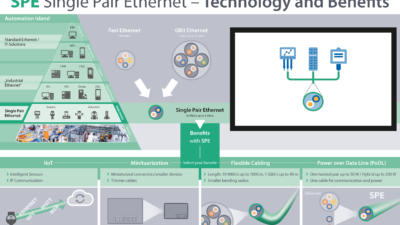The future of manufacturing lies in flexible, efficient and high-performance production that leverages data-driven intelligence and this can be achieved by implementing network technologies that utilize time-sensitive networking (TSN) functionalities.

Digital manufacturing leverages key technologies that are supporting increasingly automated operations by producing an ever-growing volume of data. The analysis of this information can generate a unique actionable insight into all manufacturing activities and how to optimize them. Thanks to this data-driven knowledge, companies can enhance flexibility, responsiveness and productivity on the factory floor. This can lead to shorter cycle times, improved efficiency while reducing waste, downtime and running costs.
Driving digital manufacturing worldwide
Organizations and governments worldwide have recognized the importance of digitalization and are promoting its adoption. One of the most well-known examples is ‘Industrie 4.0’, or Industry 4.0, from Germany. Similar approaches are ‘Made in China 2025’ and Japan’s ‘Industrial Value Chain Initiative’ (IVI), ‘Future of Manufacturing’ in the United Kingdom and the ‘Advanced Manufacturing Partnership’ (AMP) from the United States, to name a few.
All these strategies are also driving the development of innovative technologies that can support the development of smart manufacturing applications. As a result, substantial improvements in the technology to enable effective data generation, transfer and utilization have been made in the last few years. One is certainly time-sensitive networking (TSN).
This technology is one of the three solutions for the Industrial Internet of Things (IIoT) examined by the Industrial Internet Consortium (IIC) among its testbeds, as it has been identified as crucial for real-time control and the synchronization of high-performance machines. Even more, TSN functionalities can be incorporated into a single, standard open Ethernet network, thus supporting multi-vendor interoperability and integration.
What is TSN, though, and how can it deliver these capabilities?
A closer look at TSN
TSN is being defined by evolving IEEE 802.1 standards. The technology as we know it now was born in 2012 and has its foundations in the audio video bridging (AVB) technical standards on transferring audio and other real-time content over Ethernet. The goal of AVB and TSN is to provide improved synchronization, low-latency and reliability for switched Ethernet.
When applied to industrial networks, TSN can support time synchronization, traffic scheduling and shaping as well as fault tolerance. More precisely, IEEE 802.1 AS defines Grandmaster clocks that allow all devices on a network to share a common understanding of time with high accuracy, ultimately supporting determinism. IEEE 802.1 Qbv established key rules to forward and process data packets. In addition, it regulates the selection of communications paths as well as how to reserve bandwidth and time slots. More than one path is also defined to build fault tolerance mechanisms. As a result, latency is minimized and different data traffic streams can be transferred from a single network without any delays.
In particular, by utilizing TSN, companies can merge multiple industrial networks, including TCP/IP traffic, over one single physical wire. This can greatly help end users, as it can considerably simplify the overall network architecture while reducing capital expenditure (CAPEX) and the total cost of ownership. Furthermore, networks with TSN capabilities can facilitate the convergence of information technology (IT) and operational technology (OT), by sharing control and higher enterprise-level data across an organization. Ultimately, TSN makes Ethernet time-aware, allowing companies that adopt this technology to benefit from a reliable and high-performance solution to implement data-driven manufacturing strategies.
How to implement TSN now
Companies interested in realizing the benefits of TSN now, can rely on an effective and established open network technology, CC-Link IE TSN. This combines TSN capabilities with 1 Gbit/s bandwidth enabling the transfer of large volumes of control and other types of data within an enterprise in a timely manner. It also utilizes seamless message protocol (SLMP) and a memory mapped architecture to further support the IT/OT merge.
Businesses implementing this network technology can succeed in converging IT and OT as well as increasing data transparency and availability to optimize their manufacturing activities while simplifying their network infrastructures. Ultimately, by benefitting from high connectivity, next-level performance and the level of intelligence for digital manufacturing applications, companies can enhance their competitive edge in a fast-paced, increasingly demanding market.


